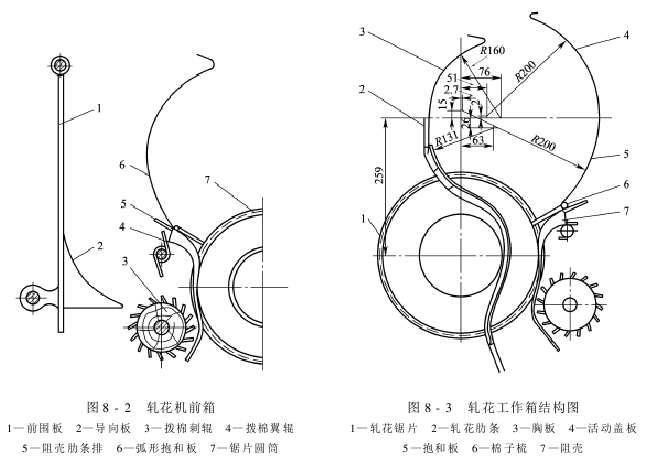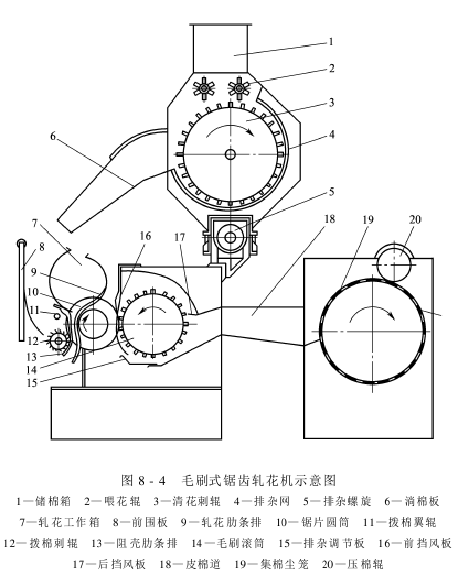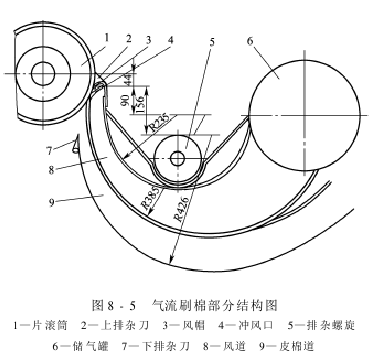Zigzag printing The structure and function of zigzag gin
The sawtooth gin is the most widely used gin in the world. my country’s commercial cotton is mainly sorted by sawtooth gins.
The structure of the sawtooth gin is relatively complex and comes in various forms. According to different brushing methods, the sawtooth gin can be divided into two types: brush type and airflow type. The former sprays the high-speed airflow generated by the fan onto the saw teeth, blowing the fibers down and sending them to the cotton collecting device. The latter relies on a high-speed rotating brush roller to blow down the fibers on the saw teeth. According to the way the cotton enters the gin, it can be divided into front box feeding and middle box feeding. In the former, the cotton enters the front box of the gin first, and the cotton is brought from the front box to the middle box by the saw teeth. The front box and the middle box The barrier ribs in between prevent large impurities from entering the middle box. The latter is that the cotton directly enters the middle box of the gin, and some large impurities in the cotton, such as stiff flaps, are cleaned in the pre-treatment process. According to the number of saw blades, sawtooth gins are divided into different blade types such as 171, 168, 139, 128, 121, 108, 100, 98, 90, 88, 80, etc.; based on Depending on the size of the saw blade pitch, sawtooth gins can be divided into 19.4mm, 18mm, 17mm, 16mm and other varieties. The diameter of the saw blade is also divided into 406mm and 320mm. In addition, there are double saw barrel type, half rib type, high efficiency type, etc.
1. The structure and function of sawtooth gins
There are many types of domestic sawtooth gins, and their basic structures are composed of flower feeding and cleaning, ginning, electrical control, transmission system and other parts.
(1) The structure and function of the flower feeding and cleaning part
1. The function of the flower feeding and cleaning part
(1) Store the cotton separated by the conveying device to ensure continuous and even production of the gin .
(2) Loosen the lint and remove impurities to facilitate the hooking of the saw teeth and improve the quality of the lint.
(3) The cotton is continuously and evenly supplied to the ginning part, and the amount of flower feeding can be adjusted within a certain range to keep the ginning machine in normal working condition.
2. The structure of the flower feeding and blowing part
The flower feeding and blowing part of the sawtooth gin consists of a cotton storage box, a flower feeding roller, a speed regulator, a cleaning licker-in, a waste removal net, a waste removal spiral, and a drain Composed of cotton boards and other mechanical parts.
3. Speed regulator
The function of the speed regulator is to reduce the high speed from the clear licker-in roller to a low speed, and can adjust the speed of the pattern feeding roller, control the amount of flower feeding or stop it according to the needs of the gin machine. Feed the flowers.
(2) The structure and function of the ginning part
The ginning part is the main working part of the gin. It consists of a front box, a middle box (also called a working box), and a rear box (also called a brushing box). Partially composed.
1. Front box
The front box is located at the front and bottom of the gin. Its function is to remove bell shells, dead cotton, small flower heads and other heavy debris in the cotton to improve the quality of the lint, protect the saw blade from damage, and evenly feed the cotton into the ginning work box. The structure of the front box is shown in Figure 8-2. There is a front wall panel made of thin steel plate in front of the front box, which is hung on the wall panel of the work box together with the two side wall panels. An arc-shaped sub-cotton guide plate is installed at the lower part of the front apron, and the front box and the working box are separated by an arc-shaped hugging plate and a shell rib row.

Front box There are also cotton-picking rollers and cotton-picking wing rollers inside.
2. Middle box (working box)
The middle box, also called the gin working box, is the main part of the sawtooth gin. Its function is to separate cotton fibers and cotton seeds. The embossed working box is composed of shell rib rows, holding plates, movable cover plates, breast plates and embossed rib rows, as shown in Figure 8-3. The cross-section of the work box is a geometric shape with a flat, round upper part and a slightly vertical peach shape. There are wall panels on both sides, and the lower end of the holding board is equipped with a cotton comb, and the saw blade extends into the work box from the gap between the embossed ribs.
3. Back box (cotton brushing box)
Back box, also called cotton brushing box, its function is to blow off the cotton fibers on the saw blade, send them to the cotton collection part, and remove the cotton fibers Some impurities (mainly infertile and broken).
According to the different brushing methods, sawtooth gins can be divided into two categories: brush sawtooth gins and airflow sawtooth gins.
The brushing part of the brush-type sawtooth gin mainly consists of a brush roller, front and rear windshields, debris discharge adjustment plate, side windshields, debris shields, cover and bottom plate, as shown in Figure 8-4 Show. Brushing lint uses the wind generated by the high-speed rotating brush roller and the brush itself to separate lint and saw teeth.

Air flow type The structure of the cotton brushing part of the sawtooth flower machine is shown in Figure 8-5. It mainly consists of an upper row of miscellaneous knives, a dust exhaust device, an air storage tank, an air duct, a hood, an air outlet, a lower row of miscellaneous knives, and a lint duct. The cotton brushing part is to shoot the high-speed airflow from the air nozzle to the saw teeth with fibers. The impact force of the air flow is used to blow the cotton fibers off the saw teeth, and then the wall effect of the jet is used to make the cotton fibers and the air flow together. Enter the lint road and be sent to the cotton collection section.

The transmission and overall structure of the air-flow sawtooth gin is relatively simple . However, the parallel operation of multiple gins requires certain pressure of air pressure, air flow, and high-pressure fans. The sealing requirements for the pipelines are higher and the pipeline design requirements are stricter. The air-flow saw-tooth gin machine has higher requirements for cleaning cotton moisture than the brush-type saw-tooth gin machine. High, finishing super-moisture cotton has problems of poor finishing quality and low output. Due to the high requirements for cotton, companies that manufacture cotton finishing equipment have stopped the production of air-flow sawtooth gins.
(3) Electrical control and Transmission system
The electrical control and transmission system vary depending on the model, and will be introduced below based on the specific model.
AAANHJJGHSFW






